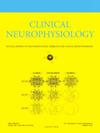Subclinical involvement of small hand muscles in early amyotrophic lateral sclerosis: Selective susceptibility leads to ‘split hand’ phenomenon
IF 3.7
3区 医学
Q1 CLINICAL NEUROLOGY
引用次数: 0
Abstract
Objectives
Split-hand phenomenon is common in patients with amyotrophic lateral sclerosis (ALS), but it is unknown if first dorsal interosseous (FDI) and abductor pollicis brevis (ABP) are affected earlier than abductor digiti minimi (ADM). We aimed to address this issue.
Methods
One clinically normal hand from ALS patients was investigated, including needle EMG of the FDI, motor amplitude, distal latency, F-waves, neurophysiological index (NI) and split-hand index (SHI). Hands were categorised as G1 (normal FDI) and G2 (FDI with neurogenic changes). In patients who agreed EMG of the 3 muscles was done. A subset of G1 patients underwent a second evaluation 4–5 months later.
Results
We studied 133 patients; EMG of the 3 muscles was done in 77 patients. There was no evidence for an earlier loss of motor units in FDI/ABP. In G2 patients, CMAP amplitude and NI were significantly lower (p < 0.001), but ADM changes were minor. Reassessment of G1 patients confirmed significant SHI, and amplitude and NI decrease in all muscles, but F-waves frequency remained stable in ADM.
Conclusions
Loss of motor units in the 3 hand muscles began in parallel, but ADM spinal motoneurons showed stronger resistance to degeneration.
Significance
Dysfunction of intrinsic spinal circuits can influence split-hand phenomenon.
早期肌萎缩性侧索硬化症的亚临床累及手部肌肉:选择性易感性导致“裂手”现象
摘要目的肌萎缩性侧索硬化症(ALS)患者常见裂手现象,但尚不清楚第一背骨间肌(FDI)和短拇外展肌(ABP)是否早于小指外展肌(ADM)。我们的目标是解决这个问题。方法对1例临床正常的ALS患者进行针刺肌电图、运动振幅、远端潜伏期、f波、神经生理指数(NI)和分手指数(SHI)的观察。手分为G1 (FDI正常)和G2 (FDI伴神经源性改变)。在同意的患者中做了三块肌肉的肌电图。一部分G1患者在4-5个月后进行了第二次评估。结果133例患者;对77例患者进行了肌电图检查。没有证据表明FDI/ABP的运动单元较早丧失。在G2患者中,CMAP振幅和NI显著降低(p <;0.001),但ADM变化较小。重新评估G1患者证实了明显的SHI,所有肌肉的振幅和NI均下降,但ADM的f波频率保持稳定。结论3块手部肌肉的运动单元丧失平行开始,但ADM脊髓运动神经元对退变的抵抗力更强。意义脊髓固有回路的功能障碍可影响劈手现象。
本文章由计算机程序翻译,如有差异,请以英文原文为准。
求助全文
约1分钟内获得全文
求助全文
来源期刊

Clinical Neurophysiology
医学-临床神经学
CiteScore
8.70
自引率
6.40%
发文量
932
审稿时长
59 days
期刊介绍:
As of January 1999, The journal Electroencephalography and Clinical Neurophysiology, and its two sections Electromyography and Motor Control and Evoked Potentials have amalgamated to become this journal - Clinical Neurophysiology.
Clinical Neurophysiology is the official journal of the International Federation of Clinical Neurophysiology, the Brazilian Society of Clinical Neurophysiology, the Czech Society of Clinical Neurophysiology, the Italian Clinical Neurophysiology Society and the International Society of Intraoperative Neurophysiology.The journal is dedicated to fostering research and disseminating information on all aspects of both normal and abnormal functioning of the nervous system. The key aim of the publication is to disseminate scholarly reports on the pathophysiology underlying diseases of the central and peripheral nervous system of human patients. Clinical trials that use neurophysiological measures to document change are encouraged, as are manuscripts reporting data on integrated neuroimaging of central nervous function including, but not limited to, functional MRI, MEG, EEG, PET and other neuroimaging modalities.
 求助内容:
求助内容: 应助结果提醒方式:
应助结果提醒方式:


